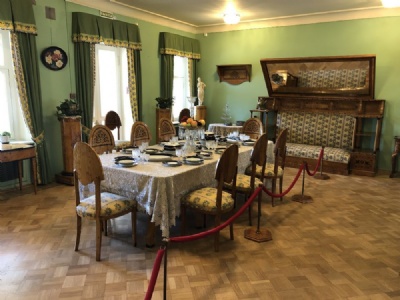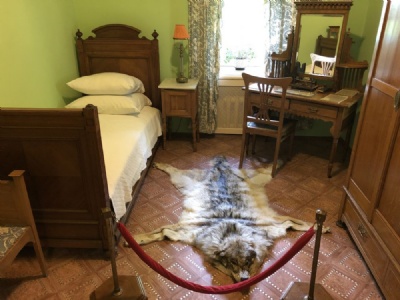Gorki Leninskiye
About 10 kilometers south of Moscow lies Gorki Leninskiye and there is a large mansion that until the Russian revolution in 1917 belonged to various dignities of the moskovite elite. The most recent was the industrialist and philanthropist S.T. Morozof. When, for security reasons, the new Bolshevik regime moved the capital from Saint Petersburg/Petrograd to Moscow in March 1918, the mansion was nationalized and given to Vladimir Lenin as a private residence. Gorki was endowed with all sorts of luxuries and a court of servants ensured that there was no distress on Lenin and his wife Nadezhda Krupskaya as well as his sister Maria. As Lenin’s health deteriorated over the coming years, he spent more and more time at Gorki. When he was subjected to an assassination attempt in September 1918, he was forced to take a longer rest. In May 1923, Lenin moved his office to Gorki, where he remained until his death on 21 January 1924.
Current status: Preserved with museum (2021).
Location: 55°30' 16.63" N 37°45' 53.78" E
Get there: Car.
Follow up in books: Service, Robert: Lenin: A Biography (2000).















The mansion and its interior are more or less preserved as it was about a hundred years ago when Lenin lived and died, which makes it a very interesting to visit. Another interesting detail is that the Rolls Royce that Lenin bought in 1922 from Britain is exhibited in the garage. It is custom-built with half-track at the rear and skis on the front to cope with the extreme winter conditions in the area. It was called Silver Ghost. In addition to transporting Lenin to Moscow, it was also used for hunting trips.
In the park there is also a reconstruction of Lenin’s study and apartment in the Kremlin. Until the fall of the Soviet Union in 1991, these rooms were preserved in the Kremlin, but were moved and reconstructed in Gorki Leninskiye afterwards. In another part of the park there are a plethora of statues, above all Lenin, but also of Stalin. Last, but not least, there is also a Lenin museum that was established in the mid-eighties. This is said to have been the last museum to be established in Lenin’s honour during the Soviet era. It is a classic social modernist building with various exhibition halls about the glorious history of both Lenin and the Soviet Union. The central part of the museum, however, is a statue of Lenin, where the boundary between historization and worship is interwoven. In a way the museum has become a museum itself.